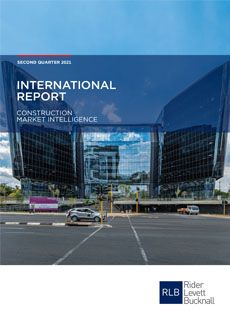According to the Rider Levett Bucknall (RLB) 2nd Quarter 2021 International Report, activity within Australia’s apartment, office, hotel and retail sectors are seeing declines in activity in the short to medium term after significant new additions to supply over the past three years.
RLB’s Oceania Research and Development Director, Mr Domenic Schiafone said, “This is not surprising, given that these sectors are historically driven by strong net migration, influxes of international students, strong employment growth in the financial/service industries, and positive tourism activity – all of which have diminished since the outbreak of the COVID-19 pandemic in March 2020.”
High-rise apartment approvals drop
While there are major high-rise residential projects that are scheduled to be completed over the next twelve months, there are increasing signs that commencements may be continuing to decline due to demand concerns.
The RLB report noted that approvals for high-rise apartments above nine storeys have continued to decline during 2021 where there was a drop of 20% in apartment numbers approved in 2020 over 2019.
Mr Schiafone continued, “The trend has continued during 2021 where a 14% drop in numbers was recorded for the first quarter of 2021 over the same period in 2020. This drop in approvals will flow on to projects commencing adding pressure on contractors to maintain work.”
“Activity in low to medium scale apartment projects in the outer suburbs continues to be strong in all major cities with new projects commencing and approvals maintaining their 2020 levels into 2021. The single dwelling housing has been buoyed by first home buyer incentives, and is recording record levels of activity across the country with approvals up by 54% in the first quarter of 2021,” he said.
Cost of materials and labour increases
The Master Builders Australia reported that 78% of domestic home builders are reporting “significant delays in being able to secure concreters, joiners and bricklayers” and “an increase in up to 10% in the cost of materials and specialist trades or labour”.
Key escalation insights from RLB offices around Australia include:
- Supply chain disruptions
- Pricing at present seems to be stable, albeit with some increase in structural trades which contractors appear to be absorbing to win work. Labour wages also on the rise and some trade shortages are starting to appear
- Falling opportunities for tendering appears to be a constant theme from contractors and key subcontractors in the next six months
- Extremely competitive marketplace
- The mining and resource sector has an increased workload and is starting to put upward pressure on labour costs
- Due to current border protection policy, it is unlikely that there will be significant inflow of labour from both overseas and interstate to offset the demand for additional labour in most states
Copper and iron ore prices reach record highs
Mr Schiafone said, “Material price rises have occurred for concrete, steel, timber, masonry product supplies and PVC based products used in hydraulic and electrical trades. The raw material prices for metals such as copper and iron ore are reaching record heights. Such rises are prompting trades to link metal prices as a condition of tender pricing to provide an adjustment mechanism for any material price increases.”
“However, despite these price pressures, recent tender returns indicate the full extent of price increases are not being passed on to clients, yet,” he added.
Looking at construction costs across the country for 2021 and 2022, RLB is forecasting the following increases for 2021: Adelaide (1.5%), Brisbane (2.0%), Canberra (2.8%), Darwin (0.8%), Gold Coast (3.5%), Melbourne (2.0%), Perth (4.0%), Sydney (1.2%) and Townsville (4.0%.)
For 2022, RLB is forecasting the following increases: Adelaide (2.0%), Brisbane (3.0%), Canberra (2.8%), Darwin (1.0%), Gold Coast (3.5%), Melbourne (2.5%), Perth (3.0%), Sydney (2.0%) and Townsville (3.0%).
Due to the current high number of COVID-19 cases, Greater Sydney has been in lockdown since the 26June 2021, with the NSW Premier locking down all construction sites in the Greater Sydney region from Monday 19 July through to 31 July 2021. Construction remains limited on sites located in the ‘high risk’ coronavirus hotspots across Sydney.
FURTHER INFORMATION:



